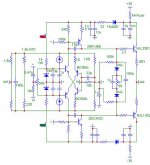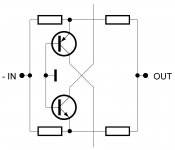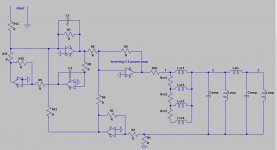homemodder thanks for the expert contribution and kind support to this thread. I see that compound triple output stage is something to go for, of course accompanied with all important details in whole schematics. Like the numbers themselves, I guess the sound of this commercial amp also quotes high in a serious listening circles.
It sounds like nothing, it depends on your source, straight wire with gain as japanese high end market wants. If longetivity in the market is a way of defining good sound then I guess it has, near 8 years on the market for the few mortals that could afford it. Albleit being built like a tank, only 14 transistors on amp, teflon circuit boards and high quality parts doesnt justify its price.
8,6 mA CCS replaces 5k6 resistor parallel to 5 k/MT trimmer.
Like this
Attachments
Adding an EF to drive the Vas is a good idea. However for testing I will keep the EF because of the thermal trak compensation which is at least in simulation perfect. I want to find out by listening test to music with very high dynamic range ( heavy metal has 6 dB dynamic range a large chorus almost 100 dB) how that sounds compared to a commercial MOSFET amp.Ill just show the vas section put on the schematic as youve shown as Ive had a couple of other members ask for it but I am not at liberty to show all facets of the circuit. Keep values more or less as per schematic you have although they can be tweaked. In the commercial version Dc servo is used, improvement is made to the input section to extend frequency response, a triple output stage is used and different compensation method is used. Anyway here is performance charts with LTspice without the improvements as stated above. Commercial version just states THD as below .005 20hz -20 Khz at all powers below clipping.
yes i made a breadbord amp with the EF power stage. The SSA BJT sit on a copper plate held at constant temp by thermostate, the Vas on a heatsink,Hi hahfran, any progress with triple output SSA? Any practical circuit tests? Regards Andrej
P.S. Today I got p-jfets, test results soon
the predriver on a heatsink, and the TT Bjts on another , added some base stopper resistors. The op stability is excellent if the temp of the SSA is set to 60 °C. Also the op of the power section is almost independent of temperature.
Thats ok. No listening tests yet because the attempt to have the amp inverting, that is input is the summing point of feedback, does not work.
But it should.
No listening tests yet because the attempt to have the amp inverting, that is input is the summing point of feedback, does not work.
But it should.
Inverting amp should have bases (+IN) grounded and input signal connected to the feedback divider (-IN), look the pic.
Attachments
Inverting amp should have bases (+IN) grounded and input signal connected to the feedback divider (-IN), look the pic.
This is the objective (pic) . This positive feedback allows to set the actual parameters of the electrical representation of a speaker in a vented box ( very simplified model) . Thus one can set such parameters as mass and compliance for a target TS alignment of any speaker in any box.
Aside from harmonics, a voltage amp is assumed to deliver real voltage, which causes a complex current to flow according to complex impedance of the speaker.
This circuit does exactly the opposite it forces a complex current which causes a real voltage thus overall a real voltage on input has a real voltage in the complex load.
This does not work with the SSA . While another by design inverting amp ( commercial AVM amp) does exactly as theory predicts. Any idea?
Attachments
Is there a point in seeing how a complex load behaves since you still have no idea how it sounds since you cannot simulate the transformation into moving air. All you have done is introduce even more variables.
Sure i can compute the acoustical output. of course then I need the radiation resistance but this does not create complication. No in fact I have reduced variables because of the effect, mutual cancellation.
I think Nelson Pass has writen an essay on Current source amps for speakers
but he did not get the point that the current source must force a complex current into a complex load such that the imaginary parts become zeroed out and hence no phase shifts no timing problems no frequency response problems.
Basically this is not new thinking anymore , the makers of active speakers are considering amp and speaker and box and acoustics of listening rooms as one system, not as independent separated devices.
About current drive I have heard that some speakers sound good using that method, other speakers sound good with voltage drive and yet other speakers sound best with a mix of both. I also remember that Nelson Pass said that for the bass driver, an amp with a low o/p impedance is essential to get a good sound.
So it sounds like you will need a custom amplifier for each speaker you build, five active elements per amp and possibly another amp for bass ? ?
If each of these active elements are not going to collectively degrade the sound, the quality will have to be very very high indeed.
You obviously have a very good command of electronics & acoustics and I would be very interested to hear such a system.
But I can't help thinking that if the same budget & resource were used to construct a much more simple, conventional design, using the finest quality components and very high quality power supplies that it might produce a sound that was more pleasing, despite being theoretically inferior.
So it sounds like you will need a custom amplifier for each speaker you build, five active elements per amp and possibly another amp for bass ? ?
If each of these active elements are not going to collectively degrade the sound, the quality will have to be very very high indeed.
You obviously have a very good command of electronics & acoustics and I would be very interested to hear such a system.
But I can't help thinking that if the same budget & resource were used to construct a much more simple, conventional design, using the finest quality components and very high quality power supplies that it might produce a sound that was more pleasing, despite being theoretically inferior.
- Status
- This old topic is closed. If you want to reopen this topic, contact a moderator using the "Report Post" button.
- Home
- Amplifiers
- Solid State
- Simple Symetrical Amplifier



